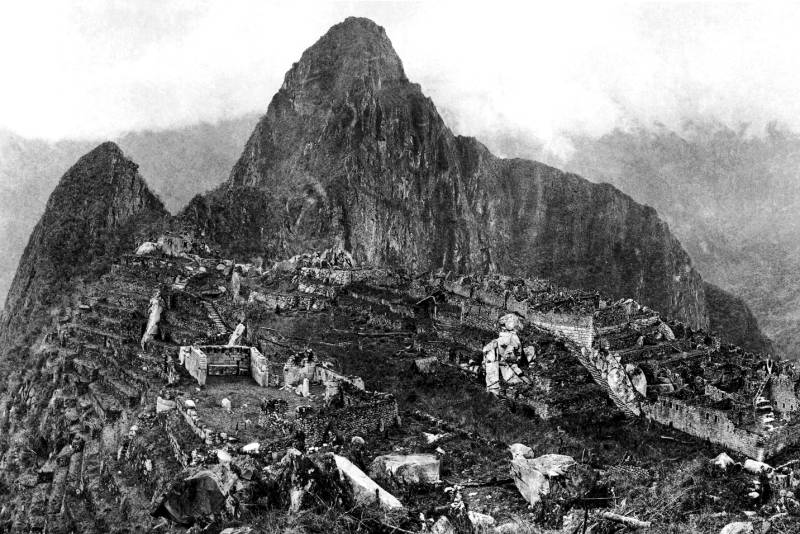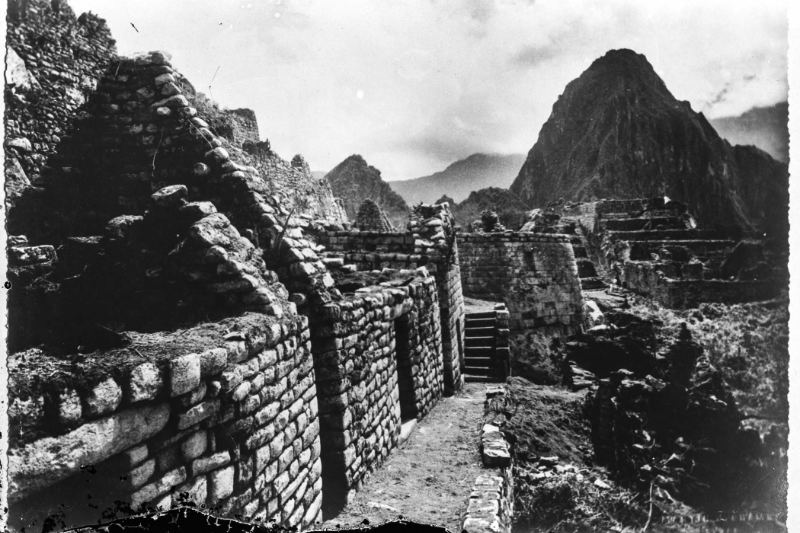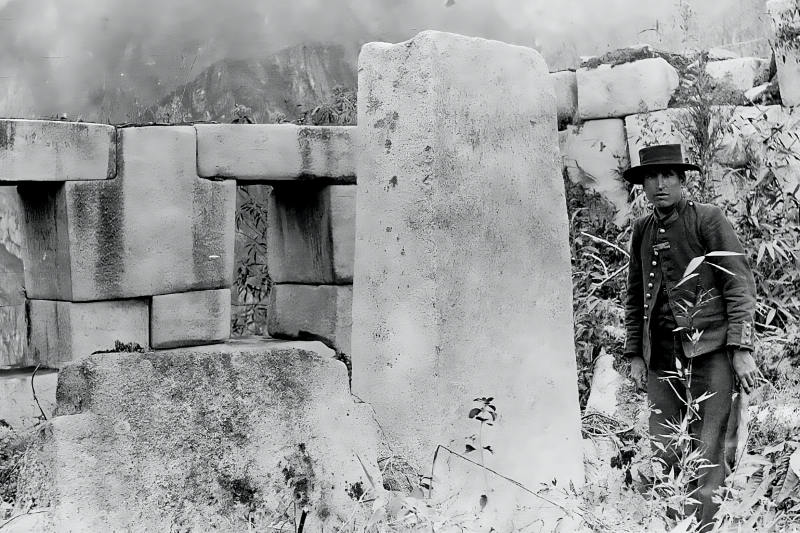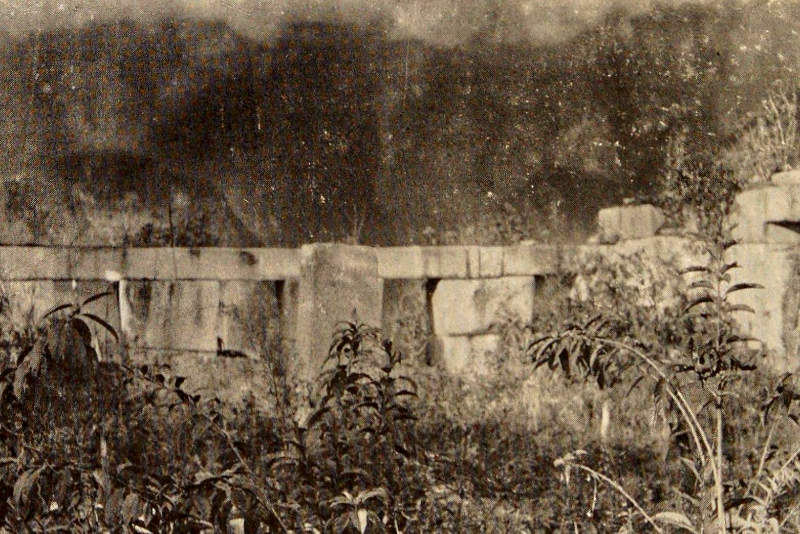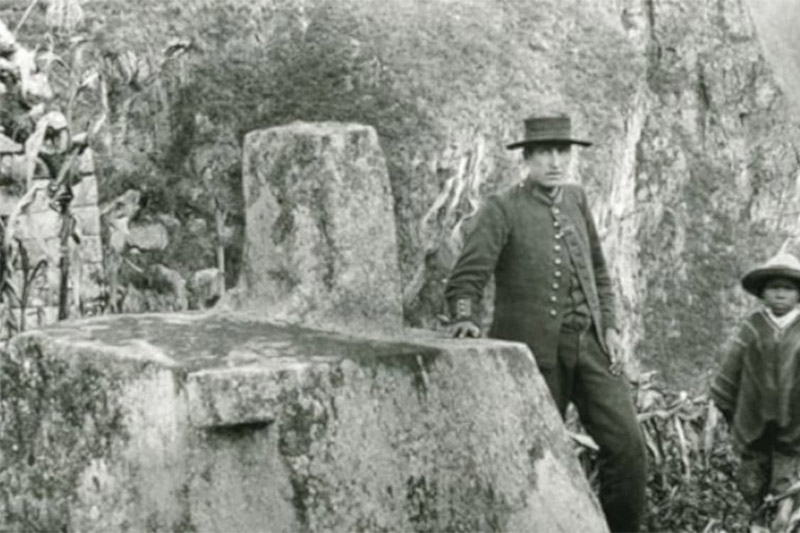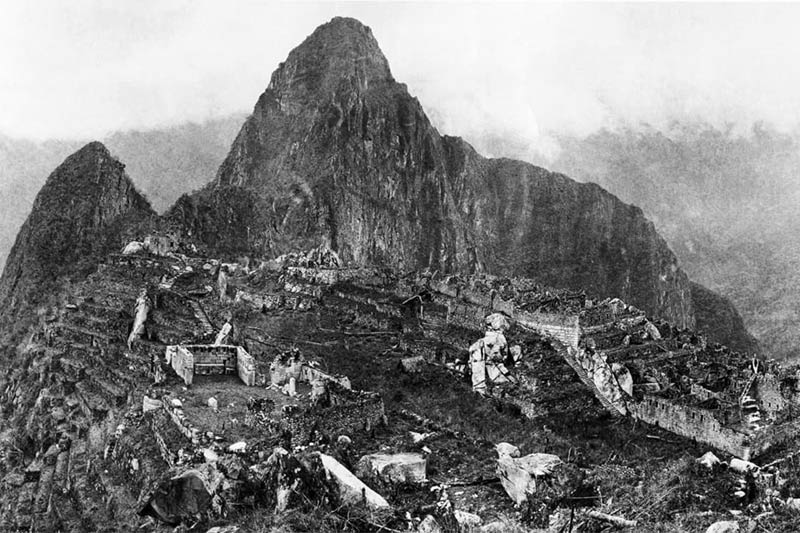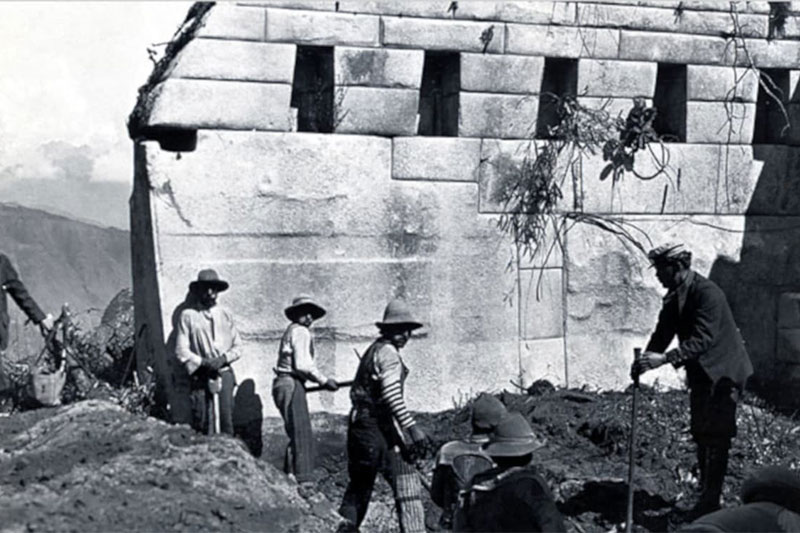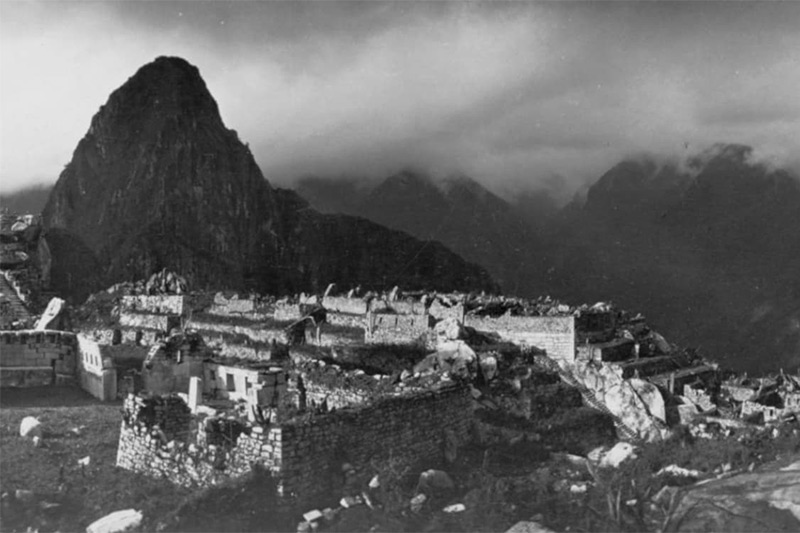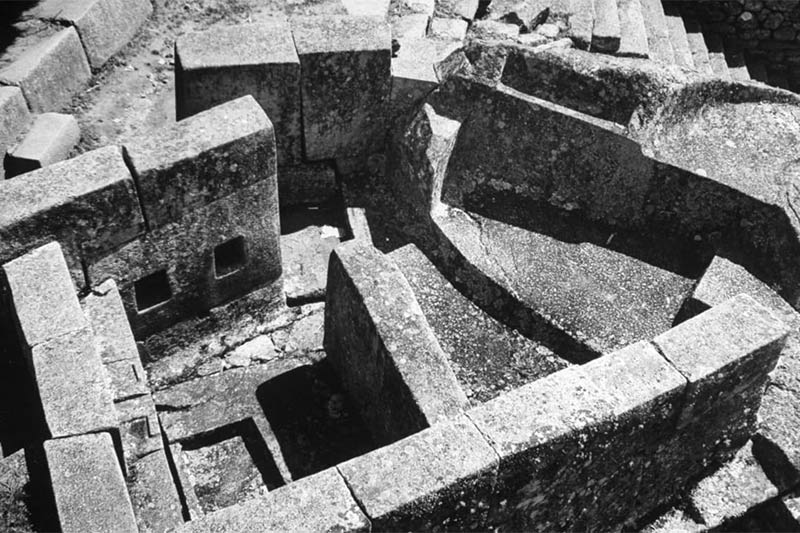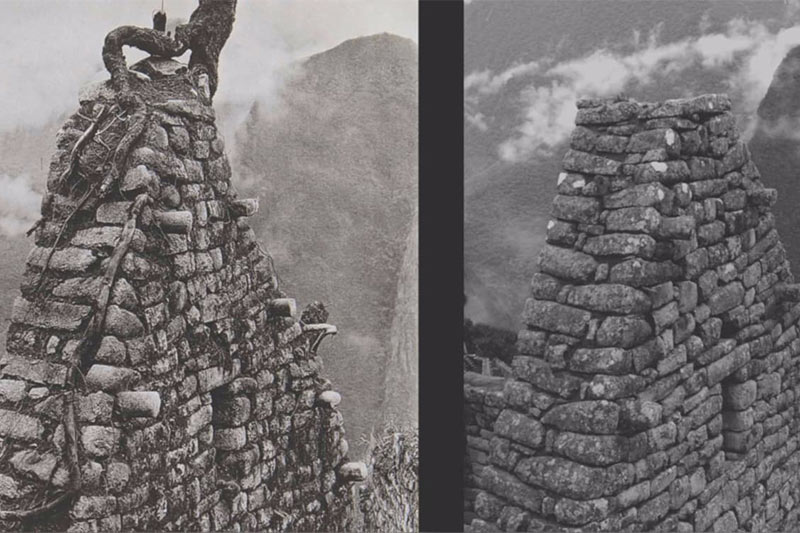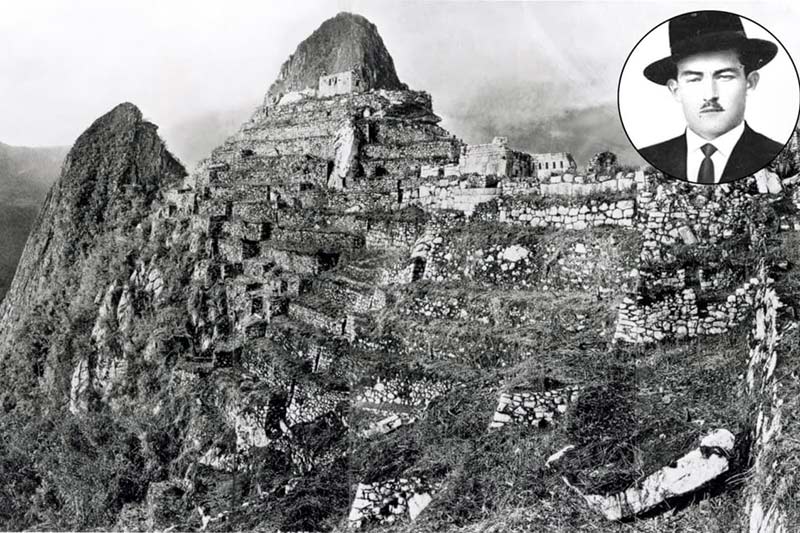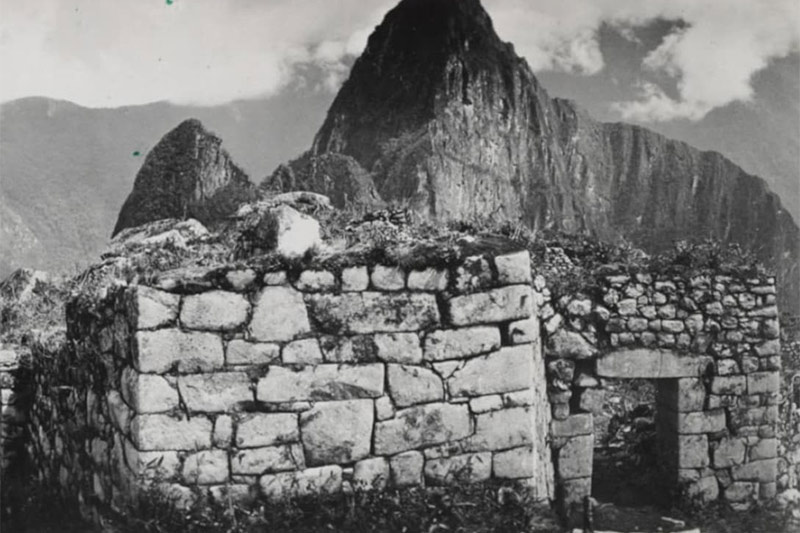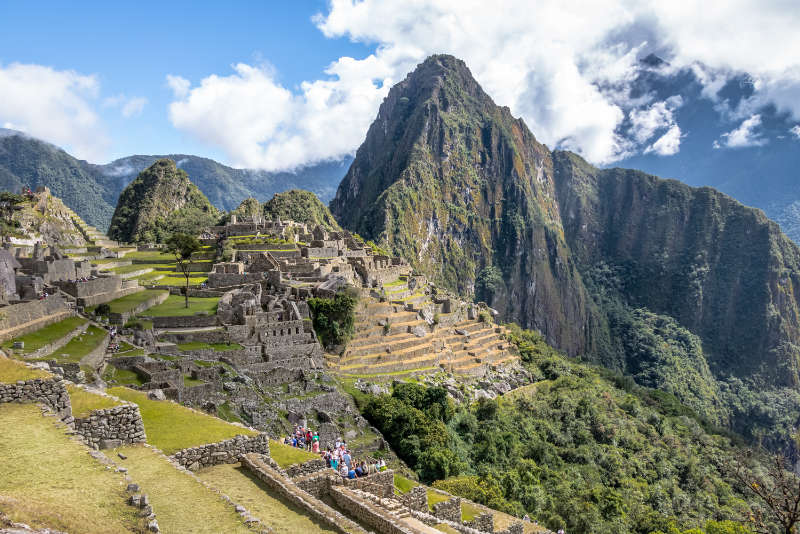History of Machu Picchu
The Inca Empire was established in Cusco approximately in the year 1,200 AD Its origin is given in relation to two famous legends: a) The legend of Manco Cápac and Mama Ocllo and b) The legend of the Ayar Brothers. In both cases the legends point to Manco Cápac as founder and first governor. In the time of the Inca Pachacutec (1438 – 1471) the Inca City of Machu Picchu was built.
- Machu Picchu before the Incas
- The construction of Machu Picchu
- Machu Picchu in the Inca period
- What was the reason for the construction of Machu Picchu?
- Machu Picchu during the wars in Vilcabamba
- Machu Picchu in the colonial era
- Machu Picchu in the Republican era
- The rediscovery of Machu Picchu
- Gallery of photos captured by Hiram Bingham in Machu Picchu
- Machu Picchu today
- Frequently Asked Questions
Machu Picchu became the preferred tourist destination in Peru and one of the most important on the planet. In 1983 it was declared a Cultural Heritage of Humanity by Unesco. In 2011 it was chosen as one of the new 7 Wonders of the Modern World.
Machu Picchu before the Incas
- The investigations carried out in the area that includes the Historical Sanctuary of Machu Picchu found ceramic pieces belonging to the Marcavalle culture, whose antiquity reaches 3 thousand years before Christ.
- However, the findings are scarce compared to those found in other regions of the Cusco Valley. Therefore, it is concluded that in the area that currently comprises Machu Picchu, Vitcos and Vilcabamba settled isolated families with practices common to the Marcavalle, the Killke and other cultures predecessors to the Incas.
- In addition, with the recent discovery in 2011 of a Wari tomb (civilization that existed 1 century before the Incas) in Vilcabamba; it can be assumed that they also managed to inhabit the Amazonian regions, including Machu Picchu.
- The truth is that the Machu Picchu region was inhabited by few people in pre-Inca times. With the construction of the Inca City, the settlement of this area of the mountainous jungle was ordered.
- Who were the Incas? The Incas were one of the cultures and ancient civilizations that developed in a large territory of Peru and part of South America. They achieved several techniques and forged their social development from a government very similar to the imperialist one, but with two divided powers where the religious and the administration had to be hand in hand. Here are some facts about the Incas:
- They are attributed a legendary origin. There are many chroniclers who collected Andean and Inca mythology. In this case the rulers came to have a divine degree after consolidating as Inca. When they received this title they were considered sons of the sun and descendants of the first son of the Sun Manco Capac who came out of Lake Titicaca or Cerro Tamputocco by the wishes of the Sun.
- They were excellent road builders. They built the most extensive road network of the entire continent and of the time. It is believed that the roads were between 40,000 and 60,000 kilometers through the Andes, the coast and part of the high and low jungle.
- They possessed an advanced architecture. They achieved a precision that is still surprising. Best of all, some constructions do not require mortar or mortar. They are united by their weight and the precision of the carving together with some metal crimps.
- They had an excellent agricultural system. They developed terraces to prevent the rivers from overflowing and to make better use of the abundant rainfall in the region where they developed. The main product to be planted was corn.
- They created excellent hydraulic engineering. They were able to understand in inexplicable ways natural water currents and the like. They conducted these waters through their main citadels practically without altering their course. That is, they used subway water channels, thaws and even rain. It is said that they even went so far as to store water spaces.
The construction of Machu Picchu
- Before Machu Picchu was built, this area was inhabited by nearby populations such as the ayllus of Vilcabamba and the Sacred Valley of the Incas. However, after the expansion of the Inca Empire, these territories became part of the growing Tahuantinsuyo empire.
- However, it is recommended to receive some types of vaccines to prevent the following diseases: chicken pox, hepatitis A, hepatitis B and yellow fever.
- According to the research conducted with the carbon 14 test, the date of construction of Machu Picchu was in 1450 AD In that year the Inca Pachacutec ruled, the main responsible for the Inca expansion. However, the works would have continued with his successor and son Tupac Yupanqui.
- According to field studies it is believed that the labor force for cultivation in the Inca City would have been formed by people from different parts of the empire (called ‘mitimaes’).
- It is presumed that the first inhabitants of the new Inca City were the ‘Chachapoyas’, people conquered by the Incas and whose origin is located in the mountainous jungle north of Peru.
- As well as Machu Picchu, the Incas expanded their territories throughout the Urubamba River valley, managing to erect important administrative centers such as Choquequirao, Vitcos, Vilcabamba and more.
- Did the Incas manage to enter the lowland jungle?
- For a long time it has been believed that the Incas only came to consolidate in the high jungle, as in the case of Machu Picchu and other Inca constructions that border precisely between the Andes and the high jungle.
- However, in recent years, several indications are being found that the Incas and even much older cultures already had contact with populations from the Amazon.
- This can be found in several findings that show products that could only be found in that place. In case it was only a trade or something similar, it is very important that a contact with the ancient tribes of the Peruvian Amazon has already been achieved.
- Another important point that supports this hypothesis is that cobblestone roads and even some Inca sculptures can be found deep in the jungle.
- There is still nothing clear about these new findings, but more and more knots are being tied that will tell us about the history of the ancient peoples of Peru, as if it were a quipu.
Machu Picchu in the Inca period
- During the Inca period, Machu Picchu was an important urban and religious center. This is evidenced by its fine polished stone buildings where its beautiful temples stand out: the Temple of the Sun, the Temple of the Moon, the Temple of the 3 Windows and more.
- It is believed that Machu Picchu had between 300 and 1,000 inhabitants during its time of splendor.
- The majority of the population of Machu Picchu was dedicated mainly to agriculture. In addition, a small part of the nobility was dedicated to religious rites.
- To feed the entire population of Machu Picchu, the Incas built platforms within the Inca City (agricultural sector) as well as in the surrounding areas (in the current archaeological sites of Patallacta and Qentemarca).
- The road network ‘Qhapac Ñan’ built to communicate Machu Picchu with the surrounding towns favored trade with the rest of the empire. However, after the death of Pachacutec as well as the construction of other citadels and roads; Machu Picchu lost prominence.
What was the reason for the construction of Machu Picchu?
- At first it was believed that Machu Picchu was built in order to serve as a military fortress and even as a resting place for the Inca Pachacutec and his family.
- However, exhaustive studies carried out by some of the best specialists have revealed that the Inca City was used as a place of worship and a religious sanctuary.
- Certainly, the interest of the Inca Pachacutec to build Machu Picchu in an exuberant geography responds to that he was admired by the place. In addition, the strategic location in the mountainous jungle served as a checkpoint of the empire with the Antisuyo (boundaries of the empire with the jungle).
- According to investigations by the Spanish historian María del Carmen Rubio, the real name of Machu Picchu was ‘Patallacta’. This is precisely the name of the place where the Inca Pachacutec wanted to be buried. However, his grave has not yet been discovered.
Machu Picchu during the wars in Vilcabamba
- Because of its location in the mountainous jungle of Cusco, Machu Picchu was a strategic point during the wars waged by Manco Inca and the other rebels of Vilcabamba between 1537 and 1572 .
- According to some historians, Machu Picchu was radically depopulated in 1537 because many of its inhabitants were recruited to join the rebel army of Manco Inca.
- The few inhabitants who remained at Machu Picchu continued to cultivate the land to supply the soldiers of Vilcabamba. In addition, some findings in the Inca City indicate that they snatched cattle from the Spanish to survive.
- According to some chronicles, in 1570 the Inca of Vilcabamba Titu Cusi Yupanqui reached an agreement with the Spaniards so that the Augustinian friars would come to evangelize the inhabitants of Machu Picchu. According to the anthropologist Luis Lumbreras, perhaps it was the evangelizers who burned the Temple of the Sun.
- In 1572, with the end of the rebellious Incas of Vilcabamba and the Spanish victory, the few inhabitants who remained in Machu Picchu had to abandon it almost entirely. The few who remained there paid tribute to the Spaniards although in a very isolated manner.
| The most widespread reasons for the end of the Inca empire | |
|---|---|
| The capture of Atahualpa | The capture of Atahualpa is the main enclave to speak of the end of the dominion of the Tahuantinsuyo. According to the chronicles, his capture took place on November 16, 1532. The capture took place in the Inca citadel of Cajamarca. This event divided much more the elites and leaders of the Tahuantinsuyo. Later, Atahualpa came to an unfortunate end. |
| Weapons superiority | Gunpowder and horses were fundamental pieces for the conquest and to position themselves as new leaders of the ethnic groups that opposed the Inca regime. Likewise, they had a better command of metal in the elaboration of armor. All this was unknown to the Incas who succumbed to the fear and the scarce information to fight against it. |
| European diseases | Another aspect completely unknown to the ancient Inca population. Some of the diseases that arrived were viruses such as smallpox and influenza. This process weakened most of the ethnic groups and therefore the agricultural processes. |
| Ethnic and Spanish alliances | There were several ethnic groups and caciques who decided to ally with Francisco Pizarro and Spanish soldiers to free themselves from the dominion of the Incas. It is believed that there were several ethnic groups that had a grudge and hunger for revenge against those known as the sons of the sun. |
| Civil War | Before the arrival of the Spaniards and surely while some diseases took hold of the north of Peru. It happened a long war of almost 5 years between the brothers Huáscar and Atahualpa for the mascaypacha. It was a long war where again the gaps were opened with the ethnic groups that had just been conquered. All this continued to divide the population. |
Machu Picchu in the colonial era
- The Inca City of Machu Picchu had barely a century of life. At a time when there was a bloody civil war between Huáscar and Atahualpa, the members of the royal family of the Inca Pachacutec (who died 50 years earlier) left the place.
- In 1572, the empire would end up being destroyed (after the end of the rebel Incas of Vilcabamba). The settlers were left to their free choice. Due to the incommunication of the Inca City with the Cusco they ended up deciding to leave Machu Picchu gradually and the dense vegetation infest the place.
- The Spanish invaders knew of the existence of Machu Picchu. The documents mention that the few farmers who lived there had to pay tribute once a year in the town of Ollantaytambo to Hernando Pizarro and the successive encomenderos.
- However, the Spanish invaders did not usually visit Machu Picchu. This probably due to the abruptness of the road as well as the little economic importance that represented for them the tributes of the Inca City. Thus, unlike other important citadels of Cusco, did not build any religious temple in its vicinity.
- With the passage of time, most of the urban sector in Machu Picchu was covered by rugged vegetation.
With the end of the Inca State, the lands of Machu Picchu were unproductive. Thus, the Inca City was gradually uninhabited. The few settlers who lived there paid tribute to the Spaniards once a year in Ollantaytambo. Until its rediscovery there lived only a handful of isolated families.
Machu Picchu in the Republican era
- In 1821 the independence of Peru from the Spanish colony was realized. Machu Picchu continued fulfilling an agricultural function for the few peasants that inhabited those lands.
- The landowners also showed no interest in cultivating the wild lands of Machu Picchu. Instead, their haciendas attracted the inhabitants of remote areas like the few families that lived in the area that includes the Inca City.
- In 1865 the Italian naturalist researcher Antonio Raimondi arrived at the foot of Machu Picchu without being able to visit the Inca City.
- According to the American researcher Paolo Greer, in 1867 the German businessman ‘Augusto Berns’ would have arrived in the Inca City with the permission of the government of Peru. Thus, he was able to market some of the treasures that Machu Picchu hid.
- In 1870 the first maps were made mentioning the existence of Machu Picchu. In 1880, the famous explorer Charles Wiener states that there is an archaeological site in the area. However, he could not get there.
- Meanwhile the inhabitants of the region, who lived for many years with the existence of an Inca archaeological site in the place, visit the Inca City regularly. This is attested by the graffiti left in an Inca wall by the inhabitants of Cusco in 1902: Agustín Lizárraga, Gabino Sánchez, Enrique Palma and Justo Ochoa.
The rediscovery of Machu Picchu
- In 1911 the American explorer Hiram Bingham arrived at Machu Picchu interested in discovering the ‘lost city of Vilcabamba’. It was so that informed about the findings of Agustín Lizárraga arrives at the Inca City helped by the local inhabitants.
- Hiram Bingham would find two families established south of the ruins: the Recharte and the Álvarez. Finally a child (son of the Recharte family) would be the one who guided the American explorer through the thick vegetation until arriving at the archaeological site.
- Hiram Bingham immediately understood the enormous historical value of his discovery, for which he requested the sponsorship of Yale University in the United States as well as the support of the National Geographic Society and the Government of Peru.
- In this way the studies of the Inca archaeological site began. The excavation works in Machu Picchu were carried out since 1912 and lasted 3 years. In that period it was possible to clear the undergrowth infesting the Inca city.
- In total Hiram Bingham made three expeditions to Machu Picchu between 1911 and 1915. During that time he managed to excavate, photograph and publish information about the Inca City.
- Although Hiram Bingham arrived at Machu Picchu and made known its importance; you can not know the ‘discoverer’ of the Inca City. This was already known by the local population and was never forgotten as it is believed. In fact the American explorer should be recognized as the ‘scientific discoverer’ of Machu Picchu.
* Courtesy National Geographic.
Machu Picchu today
- After its rediscovery Machu Picchu went through an archaeological research process where hundreds of ceramics, tools, carvings, clothing, mummies and other objects were found (46,332 pieces in total). These were sent to the Yale University of the United States between 1911 and 1916.
- The famous Peruvian photographers Martín Chambi and Juan Manuel Figueroa published images of Machu Picchu in Peruvian magazines between 1924 and 1928. Because of this, Peru’s interest in the new Inca City increased.
- Since the second half of the twentieth century, with the construction of roads and railways, the opening of Machu Picchu to visitors from the world begins. This epoch is characterized by the tourist interest of the Inca City but not of the interest for a plan of conservation and investigation adapted.
- It was not until 1970 that plans were made to adequately investigate the Inca City of Machu Picchu. At the same time, the visit of tourists from different parts of the planet increases.
- In 1981 Machu Picchu was declared as a ‘Historical Sanctuary of Peru’. In 1983 he joined the list of ‘Cultural Heritage of Humanity’ made by Unesco. Likewise, in 2007 it is recognized as one of the new ‘7 Wonders of the Modern World’ by virtual voting all over the planet.
- Today, the Inca City receives about 1.5 million tourists a year. With the measures of daily visits, it was possible to remove Machu Picchu from the list of world heritage in danger.
| Detailed information about Machu Picchu | |
|---|---|
| Before creation | The entire sector of the current Machu Picchu is believed to have been inhabited by some of the tribes of the region. The arrival of the Incas meant the moment of the almost total change of the place. |
| Construction begins | The construction order is attributed to the Inca Pachacutec. This period of time coincides with the expansion of the Inca territory and domain. This Inca was one of the main conquerors. |
| Purpose | Machu Picchu is considered one of the most important citadels that could be built. Besides being a sacred refuge, it is considered a refuge for the elite. It also has an important geolocation because it would be one of the safe links for expeditions to enter the lowland jungle. |
| Discovery and rediscovery | Machu Picchu was known and respected by the local people. That is why there are several researchers who place Agustín Lizárraga as the first discoverer, however, it was Hiram Bingham who showed the existence of Machu Picchu to the world. |
| Current importance | It is considered one of the 7 wonders of the modern world. The importance of this site lies in the economic movement it generates for the region of Cusco. Every day, it hosts thousands of tourists, which generates income for thousands of Cusqueños and is even an important enclave of Peru. |
| Some changes | During 2024 some reforms were made to the admission tickets. The main changes have to do with the official high season. Now during this period of time (June 1st to October 15th) you can find new entrance tickets to important Inca sites. |
Frequently Asked Questions
1) What is Machu Picchu?
Machu Picchu is the most important archaeological site in Peru. It is the remains of an Inca citadel. It is located in the high jungle so the construction appears on top of a mountain. It houses several stone constructions and also, a large number of retaining walls or platforms. Likewise, you can find the most emblematic temples directed to the main divinities of Peru.
2) Why was Machu Picchu built?
Machu Picchu is an important Inca citadel. Thanks to its location, it is possible to conjecture different hypotheses about the reason for its construction. The main reason is that it was a space dedicated to the Inca Pachacutec, a kind of retirement home. However, the reason is much more important, thanks to the cominos that connect with Machu Picchu you can see how it is that they direct the route to the low jungle and comes from the heights of the Cusco Andes.
3) Since when is it considered a Wonder of the Modern World?
All the 7 Wonders of the Modern World were proclaimed in 2007. This worldwide selection was inspired by the 7 wonders of the ancient world. The company in charge of conducting the survey and proclaiming the winners was New Open Corporation.
4) What other places can be visited near Machu Picchu today?
Near Machu Picchu you can find more spaces that surely were part of the Inca citadel. For example, there is the presence of Inca constructions at the top of the Huayna Picchu mountain, you can also visit the Inca Bridge and the Inti Punku sector.
5) Why does it have the name Machu Picchu?
It is called Machu Picchu because the locals knew the mountain that surrounds the entire citadel. In this sense, they did not necessarily use the name Machu Picchu, as some say that the real name is Patallaqta.
6) What does the name “Machu Picchu” mean?
This name can be literally translated into Spanish as “Old Mountain”. Forming this way, a strange triad of mountains that express the stages of the human being, this because the other mountains receive the name of “Huayna Picchu” that would be “Young Mountain” and “Huchuy Picchu” that can be translated as “Small Mountain”.
7) How to visit Machu Picchu today?
Currently there are several ways to get to Machu Picchu in addition to entrance tickets. The most popular are the variations of the Inca Trail that allow a tour of the Inca citadel. You can also find 10 entrance tickets. These tickets allow the tour of the citadel and others, in addition, short walks to remote areas such as the Temple of the Moon, Inti Punku. You can also find some tickets to the mountains.
8) Can I visit Machu Picchu all year round?
Yes, entrance to Machu Picchu is allowed 365 days a year. However, there are seasons when weather conditions can be a problem. For this reason, although you can enter Machu Picchu all year round, you will not be able to hike the Inca Trail to the Inca citadel during the month of February.
9) Are there any restrictions to visit Machu Picchu?
Yes, it will be important to check which are the tickets that allow the tour for all ages. This, because there are tickets such as for example the mountain routes like the Machu Picchu + Huayna Picchu or Machu Picchu + Temple of the Moon tickets; they are only available for people over 18 years old. After the last updates in 2024. Before they could make the tour older than 12 years old.
10) How far in advance is it possible to make a reservation to enter Machu Picchu?
It is recommended that for any entrance ticket, reservations should be made at least one month in advance. However, there are tickets in high demand which must be booked at least 3 or 4 months in advance. Only with that time in advance you will be able to have one of the tickets.
Advice from people who have been there
 By: Ernesto J.
By: Ernesto J.“Pure history in Machu Picchu“
“I had the good fortune to tour Machu Picchu with a guide who told me many details, not only about Machu Picchu but also about the history of the Incas themselves. As we toured the main temples every word made sense. It was a unique experience.“
By Ticket Machu Picchu – Last updated, December 30, 2024
